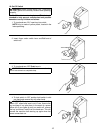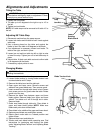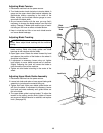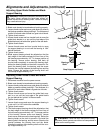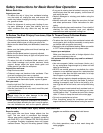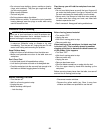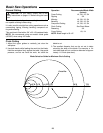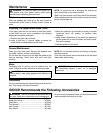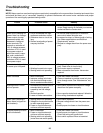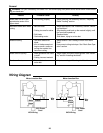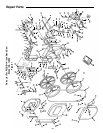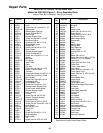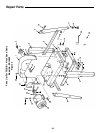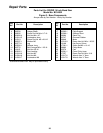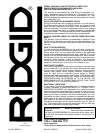
25
Troubleshooting
Motor
NOTE: Motors used on wood-working tools are particularly susceptible to the accumulation of sawdust and wood chips
and should be blown out or “vacuumed” frequently to prevent interference with normal motor ventilation and proper
operation of the centrifugally-operated starting switch.
Trouble Probable Cause Remedy
Excessive noise 1. Motor 1. Have motor checked by qualified service tech-
nician. Repair service is available your nearest
Authorized Service Center store.
Motor fails to develop full
power. Note Low Voltage:
Power output of motor
decreases rapidly with
decrease in voltage at
motor terminals. For
example, a reduction of
10% in voltage causes a
reduction of 19% in maxi-
mum power output of
which the motor is capa-
ble, and a reduction of
20% in voltage causes a
reduction of 36% in maxi-
mum power output
1. Circuit overloaded with light,
appliances and other motors.
2. Undersize wires or circuit too
long.
3. General overloading of power
company facilities.
1. Do not use other appliances or motors on
same circuit when using the saw.
2. Increase wire sizes, or reduce length of wiring.
See “Motor specifications and Electrical
Requirements” section.
3. Request a voltage check from the power com-
pany.
Motor starts slowly or fails
to come up to full speed.
1. Low voltage.
2. Windings burned out or open.
3. Starting switch not operating.
1. Request voltage check from the power com-
pany. Check size of circuit wiring.
2. Have motor repair or replaced.
3. Blow out sawdust from motor. Have motor
repaired.
Motor overheats 1. Motor overloaded.
2. Improper cooling (air circula-
tion restricted through motor
due to sawdust accumulation).
1. Feed work slower into blade.
2. Clean out sawdust to provide normal air circu-
lation through motor. See “Maintenance” sec-
tion.
Starting switch in motor
will not operate.
1. Burned switch contacts (due to
extended hold-in periods
caused by low line voltage,
etc.)
2. Shorted capacitor.
3. Loose or broken connections.
1. Have switch replaced and request a voltage
check from the power company.
2. Have capacitor tested and replace if defective.
3. Have wiring checked and repaired.
Motor stalls (resulting in
blown fuses or tripped cir-
cuit breakers).
1. Starting switch not operating.
2. Voltage too low to permit motor
to reach operating speed.
3. Fuses or circuit breakers do
not have sufficient capacity.
1. Have switch replaced.
2. Request voltage check from the power com-
pany.
3. Install proper size fuses or circuit breakers.
Frequent opening of fuses
or circuit breakers.
1. Motor overloaded.
2. Fuses or circuit breakers do
not have sufficient capacity.
3. Starting switch not operating
(motor does not reach speed).
1. Feed work slower into blade.
2. Install proper size fuses or circuit breakers.
Check that wiring will handle load.
3. Have switch replaced. Blow out sawdust.



